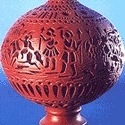The kumbhar potters of Haryana are known for their slim-necked pitchers called surahi. These water pots serve to keep the water cool. The surahis of Jhajjar and Chawani Mohalla are especially famous as the water contained in these surahis acquires a special taste due to the quality of the clay available in these low lying area.
Made from a combination of thrown and moulded parts the entire families participate in the craft process beginning with the preparation of the clay by the women and the youth. The men sit on the wheel to create the wheel-thrown surahi necks. For the round base, the clay is rolled and stretched over an upturned pot and then pressed into semi-circular terracotta dies that are engraved with patterns. After these semi-circular segments are half dry they are joined together with wet clay and left to dry in the shade. At this time the clay shrinks, leaving the surface of the die. Then the women attach the spout, neck and handles. The surahis are dipped in a slip made of barmi and sunaihri, the red and yellow clay, dried again and fired in mud kilns.
Besides the surahi the potters of Haryana produce a large variety of terracotta products such as other water pots that are used not only to cool water but also used as ritual vessels for Hindu rites in kuan puja as well as during birth and death ceremonies, oil lamps/ diya, Grains storage pots, Flower pots, piggy-banks and tea cups/ kulhars, bowls of all sizes and use, musical instruments, clay toys, human and animal figures, plaques, medallions, and wall hangings. Two-toned vases, decorative pitchers, and lamp bases with shades of black and terracotta colors are popular.
While there are potters in almost every village the potters of Jhajhar Bahadurgarh and Faridabad are the most well known.
Gallery
YOUR VIEWS
PRACTITIONERS: INDIA
Access 70,000+ practitioners in 2500+ crafts across India.
BIBLIOGRAPHY
10,000+ listings on arts, crafts, design, heritage, culture etc.
GLOSSARY
Rich and often unfamiliar vocabulary of crafts and textiles.
SHOP at India InCH
Needs to be written.






